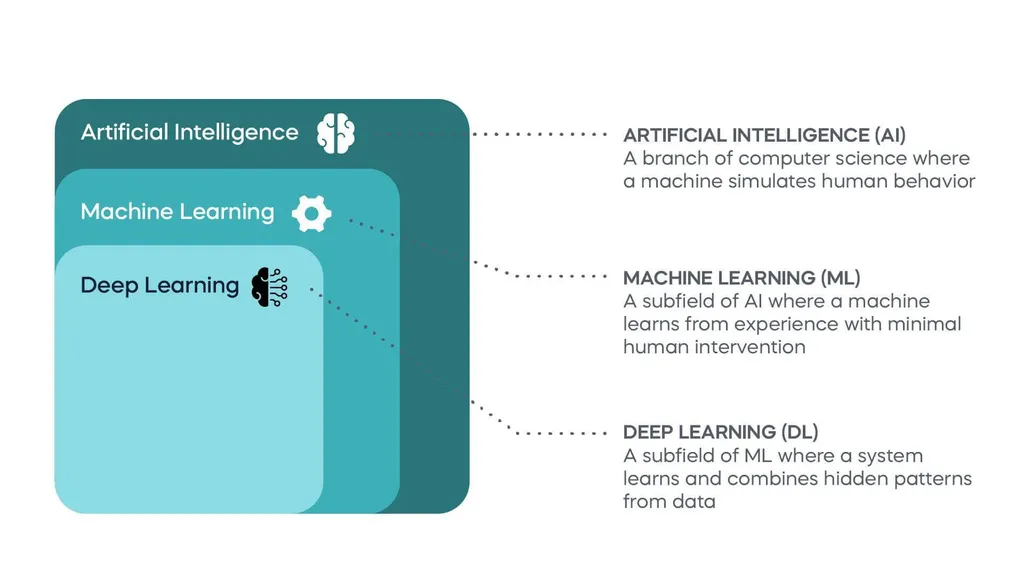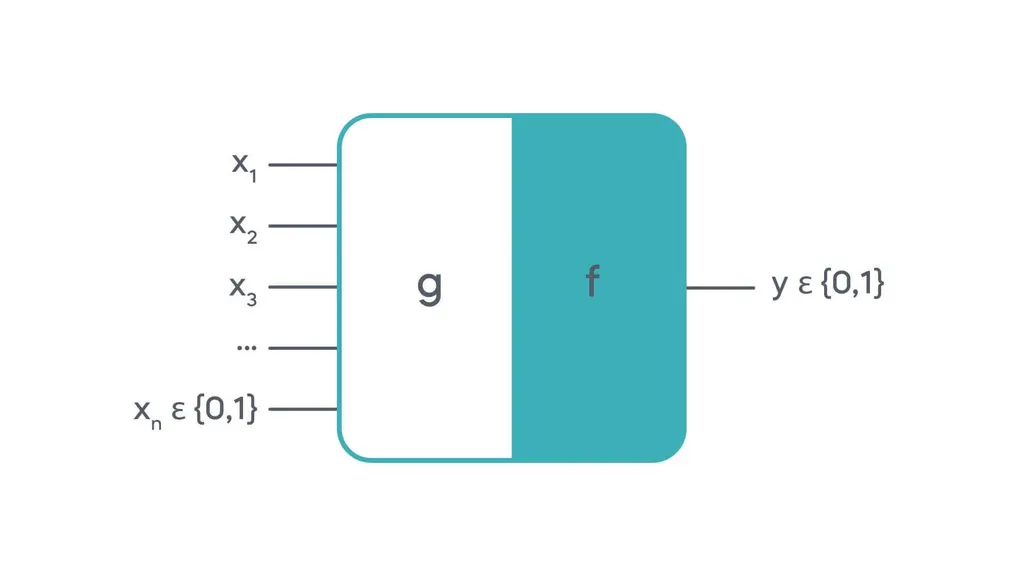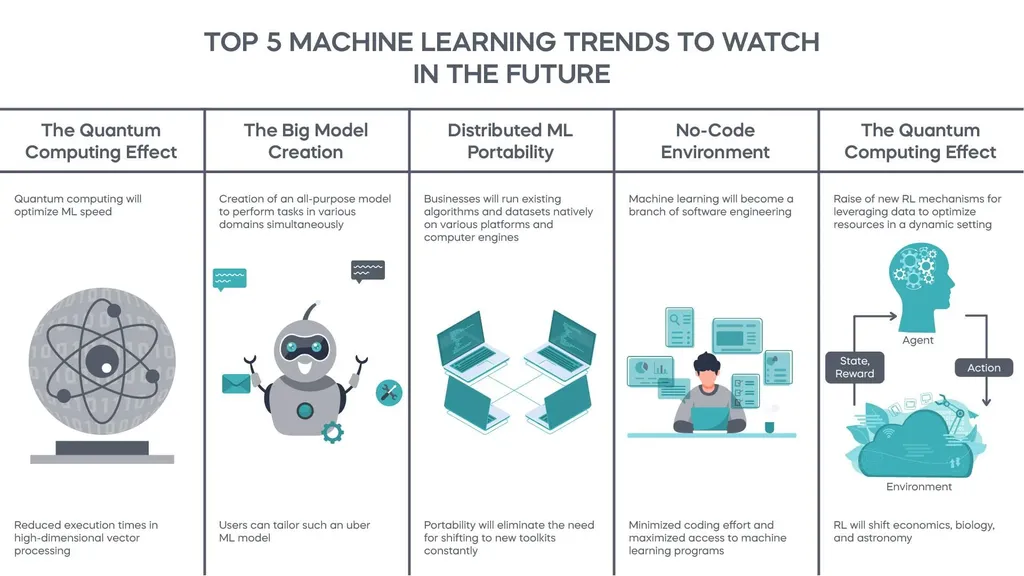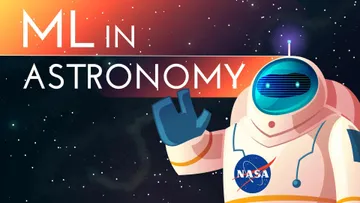In today’s digital era, businesses are actively generating an astonishing 2.5 quintillion bytes of data every single day. For those of you wondering how much that is—well, there are 18 zeroes at a quintillion!
With people using social media platforms, digital communication channels, and various contactless services, it is no surprise that big data continues to grow at a colossal rate. But how can we harness the potential of all this information in the future? And what’s machine learning have to do with it?
In this article, you’ll explore how the future of machine learning is expected to transform the business world in the next few years and what emerging trends may be worth considering.
Table of Contents
- Machine Learning vs Artificial Intelligence vs Deep Learning
- Evolution of Machine Learning
- The Future is Now: Latest Advancements of Machine Learning
- The Future of Machine Learning: Key Problems
- The Future of Machine Learning: Trends
- When Man Meets Machine: Will ML Replace Humans in the Future?
- The Future of Machine Learning: Next Steps
- FAQs
Machine Learning vs Artificial Intelligence vs Deep Learning
Many people wrongly use the terms machine learning (ML), deep learning (DL), and artificial intelligence (AI) interchangeably. To better understand the future of machine learning, one must be able to differentiate between these 3 concepts.

Artificial intelligence is an umbrella term, encompassing both machine learning and deep learning. It is inspired by the human brain and focuses on mimicking people’s behavior.
Machine learning is about creating an algorithm that a computer uses to provide valuable insights, with data being its key component. It is unique in developing algorithms that learn from data to solve problems without programming. Like a human, a model learns through experience and improves its accuracy over time.
At the core, you’ll find deep learning—an advanced feature of ML whose algorithm has its own learning mechanisms. As the heart of AI, the future of deep learning is closely related to the machine learning industry.
The harmonious work of these three domains determines the data science future and the direction of the entire technological world.
Evolution of Machine Learning
Although we can’t name a single person or event that made it all happen, the evolution of machine learning tells us just how multi-dimensional the field can be.
Some believe it all started back in 1943 when Walter Pitts and Warren McCulloch presented the world’s first mathematical model of neural networks. Here’s a simplified representation of the concept, consisting of 2 parts—g and f.

In a couple of years, the famous book The Organization of Behavior by Donald Hebb was released to later become a turning point in the future of machine learning.
It wasn’t until the 1990s that the very first machine learning technology was introduced to the world. That’s how the spam filter came into existence, and people could now save time sorting out emails. This significant milestone represented the collective effort of scientists and marked the beginning of the contemporary ML era.
To learn more about how to classify spam messages yourself, check out our Machine Learning with Naïve Bayes course.
Now, is the future of machine learning promising?
As businesses move towards the era of cloud storage, they look for innovative approaches to leveraging data. Since it’s virtually impossible to analyze great data volumes manually, organizations now adopt machine learning in big data to handle these for them. Fortune Business Insights has recently published an article, estimating that the machine learning industry will reach nearly \$226 billion by 2030—a massive growth compared to the \$19.2 billion in 2022. We could barely imagine what it would all be like in 2050. That’s probably why machine learning is the future of all technological advancements.
The Future is Now: Latest Advancements of Machine Learning
Over the last decade, many innovations in various fields have come to the forefront thanks to machine learning. Let’s briefly present 6 advancements of machine learning that are currently trending.
1. Advancements of Machine Learning – Computer Vision
Computer Vision is a type of AI where a computer can identify objects in images and videos. With the advancement in machine learning technology, the error rate has now decreased from 26% to just 3% in less than a decade.
Along with better accuracy and methods such as cross-entropy loss, humans are also able to save time in performing some tasks. If I ask you to categorize 10,0000 pictures of dogs, will you be able to do it in a few minutes? Unlike a computer with a CPU, you’ll probably take weeks to perform the task, provided you are a dog expert. In practice, computer vision has great potential in the medical field and airport security that companies are already starting to explore!
2. Advancements of Machine Learning – Focused Personalization
One of the most beneficial advancements of machine learning has to do with understanding target markets and their preferences. With the increased accuracy of a model, businesses can now tailor their products and services according to specific needs using recommender systems and algorithms. How does Netflix recommend shows? What is Spotify’s secret to playing your favorite songs? It’s machine learning that’s behind all these recent developments!
3. Advancements of Machine Learning – Improved Internet Search
Machine learning technology helps search engines optimize their output by analyzing past data, such as terms used, preferences, and interactions. To put it into perspective, Google registers over 8.5 billion searches every day. With so much data at hand, Google algorithms continue to learn and get better at returning relevant results. For many of you, that’s the most familiar machine learning technology of our time.
4. Advancements of Machine Learning – Chatbots
This is another ongoing trend businesses around the globe employ. Chatbot technologies contribute to improving marketing and customer service operations. You may have seen a chatbot prompting you to ask a question. This is how these technologies learn—the more you ask, the better they get.
In 2018, the South Korean car manufacturer KIA launched the Facebook Messenger and chatbot Kian to its customers, boosting social media conversion rates up to 21%—that is 3 times higher than KIA’s official website. And that’s just one example of how powerful machine learning technology can be.
5. The Promising Future of Deep Learning – ChatGPT
ChatGPT is a cutting-edge conversational AI model with a generative pre-trained transformer (GPT) architecture. As the most robust knowledge repository a man has ever created, it is expected to change the future of work. Essentially, the software uses advanced deep-learning techniques to deliver human-like text based on input. Developed by OpenAI, ChatGPT belongs to the large language models’ (LLMs) family. With its powerful capabilities to summarize texts, respond to highly technical inquiries, and generate coherent answers, this fine-designed tool is becoming a major workplace disruptor.
Learn how to use ChatGPT effectively and acquire fundamental AI knowledge with our course, Introduction to ChatGPT and Generative AI.
6. Advancements of Machine Learning – Transportation Trends
Many logistics and aviation companies see adopting machine learning technology as a way to increase efficiency, safety, and estimated time of arrival (ETA) accuracy.
You will be surprised to know that the actual flying of a plane is predominantly automated with the help of machine learning. Overall, businesses are largely interested to unearth ML’s potential within the transportation industry, so that’s something to look out for in the near future.
The Future of Machine Learning: Key Problems
Machine learning—as revolutionary as it may be—isn’t flawless. Its enormous potential comes with a number of challenges that are shaping up the digital world of tomorrow. A visionary, however, will always turn a stumbling block into a stepping stone. We believe today’s problems trigger tomorrow’s solutions, so let’s find out what the future applications of machine learning may be.
Data Acquisition
Machine learning technology can only produce relevant and high-quality results if we feed enough data into the model. The need for massive resources then raises a question as to how unbiased and accurate the training data can possibly be. In what way do we ensure flawless input and sound results? The "garbage-in, garbage-out" principle is what drives the proper functioning of machine learning in big data, and that’s a real challenge in today’s information-flooded environment.
Resources
Generally, the use of machine learning technology requires a lot of resources, such as powerful computers, time for developing, perfecting, and revising a model, financing, and data collection. Businesses must be ready to take on considerable investments before reaping the harvest of adopting machine learning.
Data Transformation
Contrary to popular belief, machine learning technology isn’t made for identifying and modifying algorithms—it’s about transforming raw data into a set of features to capture the essence of that information. In its autonomy, ML can make some mistakes that affect its efficiency in the long run.
Error susceptibility is certainly a major aspect to consider when transforming data with ML.
Result Interpretation and Machine Learning Technology
An ML model tends to make self-fulfilling predictions. When training data and identified patterns are wrong, the algorithms will still use this information as a basis for generating and processing new data. And it may take some time before you realize that the model has been working in favor of the underlying bias. For this reason, result interpretation may turn into a challenging task for the user.
Bias and Discrimination
How businesses prevent bias and discrimination when training data can be corrupted. They say the road to hell is paved with good intentions—a proverb that describes the ethical dilemmas of the ever-growing digital universe very well. Although you mean well when building a model to automate processes, you may unintentionally ignore or misinterpret an important human factor, which you would have otherwise prioritized. That’s a major issue when incorporating ML within recruitment and hiring practices.
The Future of Machine Learning: Trends
Dave Waters once said:
A baby learns to crawl, walk, and then run. We are still in the crawling stage when it comes to applying machine learning.
Here, we’ll outline 5 machine learning trends we believe will unfold in the next few decades. They all derive from the current developments and ongoing challenges within the industry.

1. Machine Learning Future – The Quantum Computing Effect
Industry experts have high hopes for optimizing machine learning speed through quantum computing. And rightfully so—it makes simultaneous multi-stage operations possible, which are then expected to reduce execution times in high-dimensional vector processing significantly.
Whether quantum computing will turn into the game-changer everyone’s talking about, we are yet to find out! Currently, there are no such models available on the market, but tech giants are working hard to make that happen. With some much uncertainty involved, the future of machine learning can be difficult to predict.
2. Machine Learning Future – The Big Model Creation
The next few years are expected to mark the beginning of something big—an all-purpose model that can perform various tasks at the same time.
You won’t have to worry about understanding the relevant applications of a framework. Instead, you’ll train a model on a number of domains according to your needs. How convenient would it be to have a system that covers all bases—from diagnosing cancer to classifying dog images by breed?
Of course, a well-designed quantum processor to enhance ML capabilities will certainly give that development a boost. That’s why great minds are now putting considerable effort into reinforcing the scalability and structure of such a model. That’s one of the most exciting future applications of machine learning!
3. Machine Learning Future – Distributed ML Portability
With the proliferation of databases and cloud storage, data teams want to have more flexibility when it comes to using datasets in various systems.
We foresee a great advancement in the field of distributed machine learning where scientists will no longer reinvent algorithms from scratch for each platform. Rather, they will be able to immediately integrate their work into the new systems, along with the user datasets. What does this tell you about the future of machine learning?
In the coming years, we will likely experience some form of distributed ML portability by running the tools natively on various platforms and computer engines. In this way, we’ll eliminate the need for shifting to a new toolkit. Experts in the field are already talking about adding abstraction layers to make that technological leap.
4. Machine Learning Future – No-Code Environment
As open-source frameworks like TensorFlow, scikit-learn, Caffe, and Torch continue to evolve, machine learning technology is likely to keep minimizing coding efforts for data teams.
In this way, non-programmers will have easy access to ML with no postgraduate degree required; they can simply download several packages and attend an online course on how to work with these programs. Besides, automated ML will improve the quality of results and analysis. So, in the near future, machine learning will be classified as a major branch of software engineering.
5. Machine Learning Future – The Power of Reinforcement Learning
Reinforcement learning (RL) is revolutionary—it enables companies to make smart business decisions in a dynamic setting without being specifically taught that.
With all that’s happening around us, unpredictability seems to have become the new normal. Thus, we expect ground-breaking leaps in RL to help us deal with unforeseen circumstances. And the future of machine learning is linked with that of RL.
Everyone’s talking about the optimization of resources, but it is reinforcement learning that can truly leverage data to maximize rewards, where no other model can. RL is still in its early days, so we will likely see several breakthroughs in the field within the next few years in industries like economics, biology, and astronomy.
When Man Meets Machine: Will ML Replace Humans in the Future?
With the latest advancements of machine learning, many of us can’t help but ask, “Will machines take over all the functions of a human?”
While the vision of robots ruling the world seems quite unrealistic, people are still worried about the stability of their jobs. To understand the future applications of machine learning, you should take a step back and reframe the whole image of ML.
Instead of wiping out the need for human labor, ML disruptions will lead to a job demand shift. The basic requirements for a certain role today will likely include a different set of competencies tomorrow. We like to see it this way—the machine learning industry levels up both machines and people. So, ensure you stay current and keep up with the latest trends by enrolling in the 365 Data Science program.
For businesses, machine learning will remain a buzzword in the years to come. Its prominence is inevitable, even necessary, for the world to cope with the volumes of data we produce daily. Yet, we are far from discovering its true potential and reaching maturity.
Ultimately, machines can’t do it all by themselves. As the saying goes, it takes two to tango—both people and technologies are collaboratively striving to make the world a better place, with no intention of replacing one another.
The Future of Machine Learning: Next Steps
Machine learning is an exciting field with immense untapped potential. So, if you're an aspiring data scientist and ML technologies fascinate you, then you should start learning today.
The industry is evolving every day, with new breakthroughs being discovered as we speak. Don’t let yourself fall behind on the trends! Enroll in “The Machine Learning Process A-Z” course and build up your knowledge to secure your data science future career.
Ready for the next step toward a career in data science?
The 365 Data Science Program offers self-paced courses led by renowned industry experts. Starting from the very basics all the way to advanced machine learning technology, you will learn by doing, with a myriad of practical exercises and real-world business cases. Sign up for free and embark on your data science journey today.
FAQs











